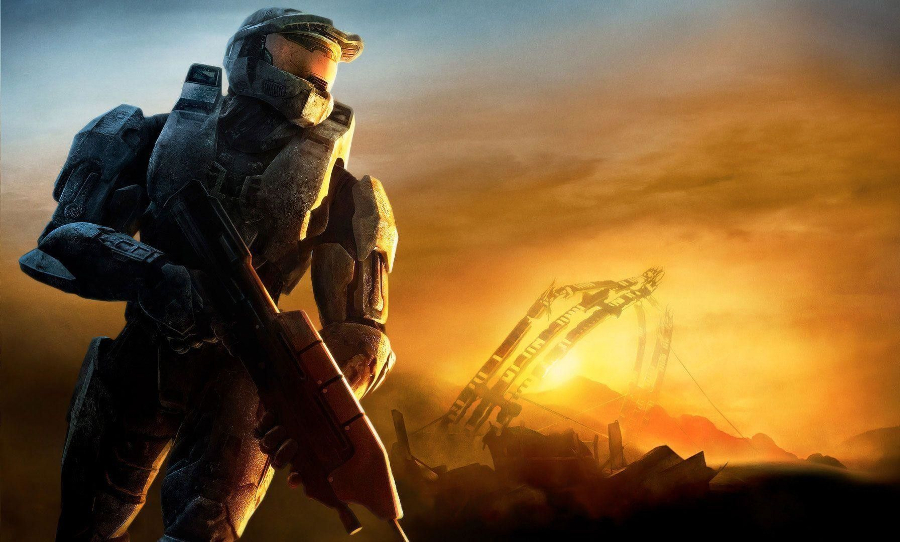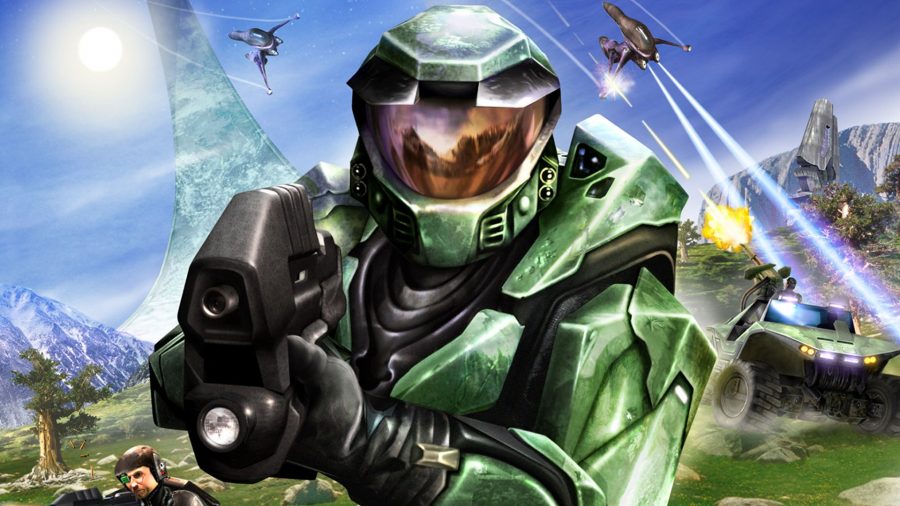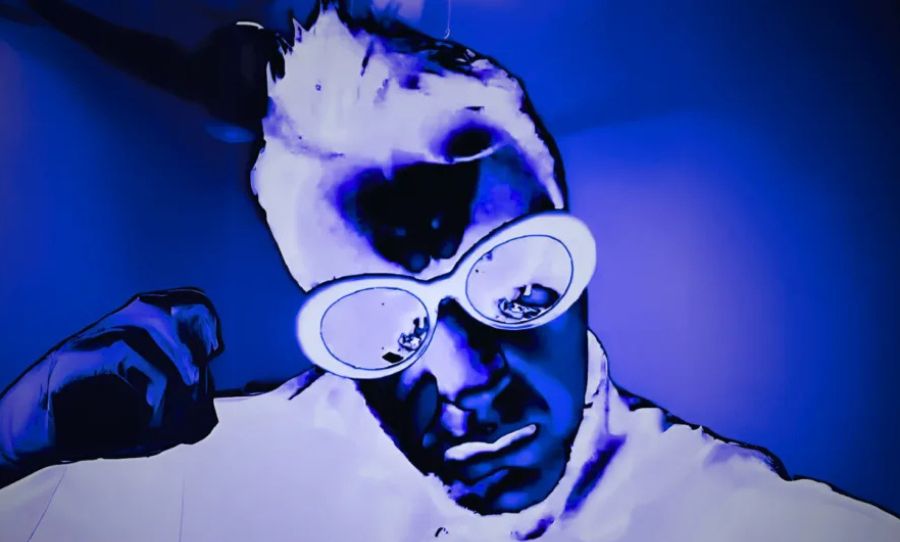This is the tale of Halo, an ambitious shooter that carried a console on its shoulders, while simultaneously etching a new universe into the annals of sci-fi.
Bungie began as a two-man team of college students with relatively little to no experience in game design. Their story of success is one of perseverance, dedication, and ingenuity. In under a decade, Bungie had become The Beatles of game design, flying a banner that read one word: Halo.
Originally conceived as a top-down, anthill strategy game, Halo: Combat Evolved, and more importantly Master Chief, would almost single-handedly garner Microsoft’s clunky new console universal appeal and undying status as a gaming giant.

Bungie beginnings
Halo’s story began many years earlier with a game called Marathon. Founded by two students at the University of Chicago, Alex Seropian and Jason Jones, and their first game was a Pong clone called Gnop! (Pong spelt backwards).
It was released in 1990 free of charge. Bungie quickly followed up with Minotaur: Labyrinths of Crete (which Jones wrote while doing an artificial intelligence class). Minotaur was largely funded by Seropian’s wife and packaged by hand, seeing modest success and enough capital to fund another project.
The next was an FPS shooter inspired by id Software’s Wolfenstein 3D, and Pathways into Darkness was a critical and commercial success. Up until this point, Bungie programmed games exclusively for the Macintosh, while nearly all other games focused on Windows.
Bungie then upgraded from a one-bedroom apartment next to a crackhouse to a studio in Chicago’s South Side. Their next game was another FPS called Marathon (1994) and is the first-ever vertical shooter, allowing players to look up and down as well as jump to higher ground.
After a Macworld Expo, Bungie was swarmed with interest leading to a sequel, Marathon 2: Durandal (1995), introducing co-op into shooters for the first time. A trait which later became a Bungie staple.
Following this, Bungie made a leap to strategy games with Myth: The Fallen Lords another critical success for the genre, winning several awards and earning a large online community. This enabled Bungie to establish a second office branch in San Jose, California, called Bungie West.

Halo: Combat Evolved
In 1999, Bungie announced its ambitious next project, Halo: Combat Evolved. Originally conceived as a top-down, real-time strategy game, it soon grew into an FPS, a genre the company was now renowned for.
Halo’s debut occurred at the Macworld Expo in 1999 and was personally introduced by Apple CEO Steve Jobs. “One of the coolest (games) I’ve ever seen” is how Jobs introduced Halo, and as it turns out, he was pretty spot on.
Despite the praise, Bungie’s scope was even larger than Macintosh. By June 2000, Microsoft had acquired Bungie Studios, launching Halo: Combat Evolved as an exclusive FPS title in order to popularise their ambitious new console, the Xbox.
When it dropped with the Xbox on November 15, 2001, the applause was deafening. Critics and fans alike raved about the gameplay’s forward-thinking mechanics, claiming it pushed the boundaries of gaming itself.
Halo: Combat Evolved broke sales records, selling a million copies within 5 months, and now being shifted in tandem with all Xbox consoles. Fans instantly fell in love with the story of Master Chief, the Covenant, and the fearsome flood.
The Xbox was the first-ever console I owned and I can vividly remember two things. The oversized controller, and the gut-punching grunt in Halo. It blew my malleable mind into outer space and I still get waves of nostalgia just thinking about it.
The phenomenon evolved into literary success with Halo: The Fall OF Reach, a prequel to the game that soon became a bestseller. Eric Nylan’s trilogy of Halo novels has spawned countless other entries into the expanding universe and a legion of hardcore fans.
Charging forth
Bungie received significant funding from Microsoft to create a sequel, and in turn, more confidence to become more ambitious. The result: multiplayer.
Many marked improvements were made to Halo 2 including dual-wielding, more enemy types, hijacking vehicles, turrets, and regenerating health bars. But nothing was more groundbreaking than its online multiplayer mode.
The hype for Halo 2 had reached fever pitch. In a massive marketing campaign during the weeks prior to release, a record-breaking 1.5 million pre-order copies were bought.
Halo 2 once again met resounding praise and is frequently referred to as proof that a sequel can supersede the original, selling 8 million copies and becoming the highest-selling game on the Xbox console.
When it dropped, Halo was the highest-grossing release in entertainment history, with critics praising the gameplay innovated and vivid enhancements to the game’s score. The dev team hired a host of popular musicians to add their touches to the game’s music including Steve Vai, Nile Rodgers, Incubus, Breaking Benjamin, and in secret, John Mayer, who lays down a smooth bluesy solo on the epilogue track.
Even now, it’s hard to fully grasp how radically influential Halo 2 was, and still is today. Online matchmaking and system link multiplayer modes are gaming mainstays thanks to Halo and now seem simply intuitive. Halo 2’s multiplayer system is often considered a landmark moment for the medium and was cited as the best of all time. This was until Halo 3.

Closing the trilogy
Someway, somehow, Bungie had managed to live up to the hype of Halo: Combat Evolved with Halo 2. Hell, they even exceeded it.
When officially announced at E3 2006, Halo 3’s expectations were astronomical. And for such a groundbreaking game, everything had to be better. The campaign, the multiplayer, the innovation, it all had to improve if Halo was to uphold its reputation as championing the forefront of gaming.
To begin, Bungie radically overhauled the audio. To put it into perspective, Halo 3 had 50,000 pieces of audio while Halo 2 included only 15,000. Marty O-Donnell, the composer for the first two games, commanded a massive 60-piece orchestra and 24-piece choir to craft a now-historic score.
The graphics improved drastically, now incorporating HDR (high dynamic range), global lighting, and depth-of-field vision, among many other textural enhancements.
Coming up to launch, Microsoft aggressively ramped up the marketing of their famed golden child. Bungie employees were flown around the world and massive launch parties were held in honour of the global phenomenon.
I vividly remember my local gaming store holding an event for the midnight release, fully equipped with actors in a full combat suit as well as a life-size Warthog. Yes, they made real-working versions of their famous battle jeeps. In fact, Bill Gates famously sold and signed the first copy of Halo 3 at Best Buy in Bellevue, Washington on September 25, 2007.
Upon release, Halo 3 saw rapturous praise. Bungie had once again defied the odds and created am incredible game that would go down in history.
Again breaking sales records, Halo 3 made $170 million in the first 24 hours, and breaking $300 million in the first week. Pretty remarkable considering it only sold on one console, the Xbox 360.
Couple it with the fact that the Xbox 360 is Microsoft’s best-selling console by almost double (84 million), then you begin to realise the magnitude of Halo’s impact upon the world. More importantly, how critical Halo was to the success of the Xbox.
The Xbox 360 marked the only time that Microsoft has been equal in sales with its fierce rivals, Sony, with the PlayStation 3 selling 87 million units.
By 2008, Microsoft claimed that the game had sold 8.1 million copies. Advertising Age reported that movie studio executives were convinced the release of Halo 3 harmed box office receipts; the week’s take was 27% less than the previous year’s yield.
Ultimately, Microsoft wouldn’t be what they are today without Halo and its hero, Master Chief. By daring to innovate and strive for change, Bungie set the standard for modern First-Person Shooters, multiplayer games, and sci-fi heroes. And none are arguably more iconic than Spartan-117, the Master Chief.



